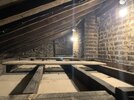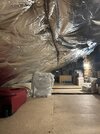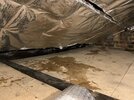We have a problem with white mould on our rafters, which has been put down to poor ventilation. I am hoping for some advice on how to improve our situation ...
This is a late 19th century terrace house with a London pitch or butterfly roof, which gives us two completely separate, shallow loft spaces divided by a central gully that runs from front to back and sits almost directly on top of the ceiling. These lofts have always been acessible until last Autumn when we had hatches and insulation installed, with boards put down for storage. The builder fitted wire wool type insulation under the boards and then stapled foil insulation rolls to the undersides of the joists - which was clearly a mistake.
After a couple of months we noticed damp patches on the ceiling and on further investigation we could see that water was collecting between the foil and underside of the roof felt, then running down the top side of the foil and dripping down near the gulley. A section of the foil was removed along the top and bottom of the roof slope to allow air circulation in January but the problem persisted and mould began to develop on the joists and underside of the felt. In March we completely removed the foil insulation and the joists were found to have high moisture levels. (It is possible that the loft has historically been quite damp but clearly the foil has magnified the problem.)
The situation improved over the summer but the mould is still present and we have decided to have it treated and removed. In order to restrict its return we need to improve the ventilation in the loft. At the moment, there is only one visible airbrick in one side of the loft. Airbricks that we thought had been installed 10 years ago, and which we can see from the front of the house do not seem to be visible from inside. (I don't think we have a cavity, but maybe it's a double brick thickness and the naughty builder only put the airbtick on the outside, where it can be seen but is doing no good.)
We will try to open up these airbricks from the inside, which hopefully can be done without scaffolding.
The slate roof does have some vent tiles but it seems they may be blocked inside by the felt. Is it advisable to cut the section of felt directly below the vent tiles, or could this lead to rain getting inside ?
Other suggestions have been to install humidistat extractor fans or PIV units in the lofts. Would this be advisable ? And if so, should they be vented through the end walls or through the roof ?
If anyone can offer any advice we would very much appreciate it.
Earl




This is a late 19th century terrace house with a London pitch or butterfly roof, which gives us two completely separate, shallow loft spaces divided by a central gully that runs from front to back and sits almost directly on top of the ceiling. These lofts have always been acessible until last Autumn when we had hatches and insulation installed, with boards put down for storage. The builder fitted wire wool type insulation under the boards and then stapled foil insulation rolls to the undersides of the joists - which was clearly a mistake.
After a couple of months we noticed damp patches on the ceiling and on further investigation we could see that water was collecting between the foil and underside of the roof felt, then running down the top side of the foil and dripping down near the gulley. A section of the foil was removed along the top and bottom of the roof slope to allow air circulation in January but the problem persisted and mould began to develop on the joists and underside of the felt. In March we completely removed the foil insulation and the joists were found to have high moisture levels. (It is possible that the loft has historically been quite damp but clearly the foil has magnified the problem.)
The situation improved over the summer but the mould is still present and we have decided to have it treated and removed. In order to restrict its return we need to improve the ventilation in the loft. At the moment, there is only one visible airbrick in one side of the loft. Airbricks that we thought had been installed 10 years ago, and which we can see from the front of the house do not seem to be visible from inside. (I don't think we have a cavity, but maybe it's a double brick thickness and the naughty builder only put the airbtick on the outside, where it can be seen but is doing no good.)
We will try to open up these airbricks from the inside, which hopefully can be done without scaffolding.
The slate roof does have some vent tiles but it seems they may be blocked inside by the felt. Is it advisable to cut the section of felt directly below the vent tiles, or could this lead to rain getting inside ?
Other suggestions have been to install humidistat extractor fans or PIV units in the lofts. Would this be advisable ? And if so, should they be vented through the end walls or through the roof ?
If anyone can offer any advice we would very much appreciate it.
Earl





